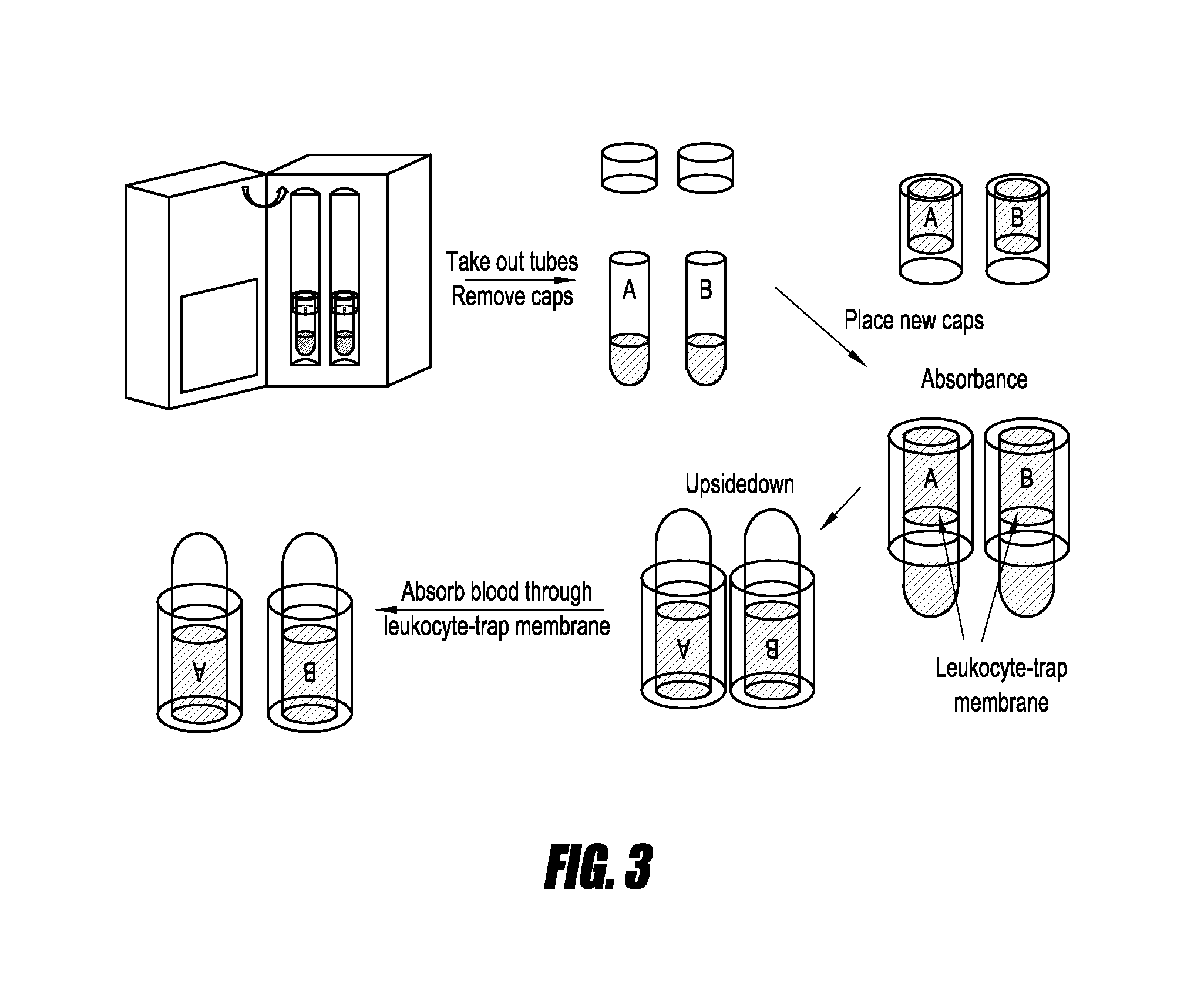Portable device for ex vivo stimulation of whole blood
a technology of ex vivo stimulation and portable devices, which is applied in the field of portable devices, can solve the problems of large variation in gene expression analysis from institute to institute, and the value cannot be converted to the amount of the gene in the original materials,
- Summary
- Abstract
- Description
- Claims
- Application Information
AI Technical Summary
Benefits of technology
Problems solved by technology
Method used
Image
Examples
example 1
Ex Vivo Blood Stimulation
[0067]FIGS. 1-5 show methods and devices for collecting blood, processing the samples, and performing an mRNA assay on the processed blood sample in accordance with some embodiments. As illustrated in FIG. 1, tubes A and B both contain heparin prior to filling with whole blood cells. In other embodiments, heparin (or another anticoagulant) may be added to the tubes manually). Tube A is used as a control because it does not contain any stimulant. Tube B contains a dried stimulant. As above, in some embodiments, a stimulant, including an additional stimulant, is added manually. The blood is collected into the sample tubes followed by shaking or agitating the tubes to ensure that the heparin and / or stimulant mix with the collected blood.
[0068]Next, as shown in FIG. 2 a disposable incubator is used to incubate the blood samples of FIG. 1. In several embodiments, incubation is performed under physiological conditions. In some embodiments, a temperature of about 3...
example 2
Blood Collection Tube Manufacturing and Testing
[0071]Often, blood collection tubes are made of glass, which due to manufacturing defects, exposure to fluctuations in temperature, or mishandling, can break. Given that blood samples are often collected in order to assess the health status of a patient, the blood sample may contain pathogens, chemicals, or other substances that present a danger to the individual(s) collecting and / or analyzing the blood samples. As such, in several embodiments there is provided a non-glass blood collection tube that reduces the risk of tube breakage and unintended exposure of personnel to patient blood samples. Non-glass blood collection tubes, such as those disclosed herein, are advantageous in comparison to traditional glass tubes, as collected blood samples can be stored frozen below −70° C. (e.g., for example after a stimulation protocol), but with a reduced risk of breakage during the thawing process which precedes final analysis. In several embodi...
example 3
Comparison of Manufactured Blood Collection Tubes and Multi-Well Strips
[0075]After confirming the reproducibility of manufacturing non-glass blood collection tubes, the following experiments were performed to assess whether such collection tubes perform sufficiently well as more traditional ex vivo blood stimulation methods (e.g., placement of small volumes of blood in wells and individually adding stimulating agents.
[0076]Blood collection tubes were manufactured as described above. Three tubes were stored at 4° C. (tubes PHA 4C #1, #2, and #3 in FIG. 9) or room temperature (PHA RT in FIG. 9) for 20 days. Blood was then drawn into 6 tubes: a control heparin tube, a plain heparin tube, and 4 PHA-containing tubes. The blood from the control heparin tube was stimulated (by PBS or PHA) in micro-plate tube strips (3 wells each, 60 μL blood / well). The remaining 5 tubes were incubated at 37° C. for 4 hours. Various mRNA were quantified by using SYBR green real time PCR as described previou...
PUM
 Login to View More
Login to View More Abstract
Description
Claims
Application Information
 Login to View More
Login to View More - R&D
- Intellectual Property
- Life Sciences
- Materials
- Tech Scout
- Unparalleled Data Quality
- Higher Quality Content
- 60% Fewer Hallucinations
Browse by: Latest US Patents, China's latest patents, Technical Efficacy Thesaurus, Application Domain, Technology Topic, Popular Technical Reports.
© 2025 PatSnap. All rights reserved.Legal|Privacy policy|Modern Slavery Act Transparency Statement|Sitemap|About US| Contact US: help@patsnap.com



